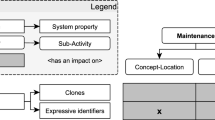Abstract
Requirements engineering (RE) is essential to succeed in software projects. That is, it is important to elicit sound requirements for proper performing of RE. If some requirements are inconsistent with a given objectives and constraints, these requirements may hinder the performance of RE. For this reason, it is necessary to pre-check the consistency of requirements. We propose the metrics for evaluating requirements by considering given objectives and constraints. Our metrics are validated by two sample scenarios: “Payroll and Roster Planning of Hospital” and “Noise Source Location System.” At the result, we expect that these metrics would be helpful when selecting a set of consistent requirements.











Similar content being viewed by others
References
Karl W (2003) Software requirements. Microsoft Press, Redmond
Robertson S (2006) Mastering the requirements process. Addison Wesley, Reading
IIBA (2009) A guide of business analysis body of knowledge. International Institute of Business Analysis, Toronto, Ontaria, Canada
Davis AM (2005) Just enough requirements management. Dorset House Publishing, New York
Karlsson J, Ryan K (1997) A cost-value approach for prioritizing requirements. IEEE Softw 14:67–74
Leite JCSP, Freeman PA (1991) Requirements validation through viewpoint resolution. IEEE Trans Softw Eng 17:1253–1269
Byun J, Rhew S, Hwang M (2012) A study on techniques for measuring requirement suitability considering project objectives and constraints. In: Lee G et al (eds) Convergence and hybrid information technology, ICHIT 2012, CCIS 310. Springer, Berlin, pp 449–457
Farry KA (2001) Customer-centered products: creating successful products through smart requirements management. Amacom, New York
Heitmeyer CL, Jeffords RD, Labaw BG (1996) Automated consistency checking of requirements specifications. ACM Trans Softw Eng Methodol 5(3):231–261
Lee G, Sacks R, Eastman CM (2002, November) Dynamic information consistency checking in the requirements analysis phase of data modeling. In: European conference for process and product modeling, Slovenia, pp 285–291
Wilson WM, Rosenberg LH, Hyatt LE (1997) Automated analysis of requirement specifications. In: Proceedings of the 19th international conference on software engineering ICSE 97, ACM Press, pp 161–171
Costello RJ, Liu DB (1995) Metrics for requirements engineering. J Syst Softw 29(1):39–63
Boehm BW (1984) Verifying and validating software requirements and design specifications. IEEE Softw 1:75–88. IEEE. Retrieved from http://ieeexplore.ieee.org/xpls/abs_all.jsp?arnumber=1695100
Davis A, Overmyer S, Jordan K, Caruso J, Dandashi F, Dinh A, Kincaid G et al (1993) Identifying and measuring quality in a software requirements specification. In: Proceedings first international software metrics symposium, IEEE Computer Society Press, pp 141–152
Serebrenik A, Mishra A, Delissen T, Klabbers M (2010) Requirements certification for offshoring using LSPCM. In: 2010 seventh international conference on the quality of information and communications technology QUATIC. IEEE. Retrieved from http://ieeexplore.ieee.org/lpdocs/epic03/wrapper.htm?arnumber=5655261
Higgins A, Hajkowicz S, Bui E (2008) A multi-objective model for environmental investment decision making. Comput Oper Res 35:253–266
Saaty TL (1980) Analytic hierarchy process. Decis Anal 50:579–606
Johnson O (2004) Information theory and central limit theorem. Imperial Collage Press, London
Novak V (2005) Are fuzzy sets a reasonable tool for modeling vague phenomena? Fuzzy Sets Syst 156:341–348
Byun JW, Kim JH, Rhew SY, Hwang MS (2010) A technique for classifying requirement/stakeholder and generating information for negotiation using Kano model and statistical technique. J KIISE 37:161–169
Lauesen S (2002) Software requirements: styles and techniques. Addison-Wesley, Harlow
Saaty TL (1988) What is the analytic hierarchy process?. Springer, Berlin, pp 109–121
Zadeh LA (1965) Fuzzy sets. Inf Control 8(3):338–353
Cox J, Goldratt EM (1986) The goal: a process of ongoing improvement. North River Press, Croton-on-Hudson
IEEE (2009) IEEE Std 100-2009, the authoritative dictionary of IEEE standards terms. IEEE Computer Society, Los Alamitos
IEEE (1990) IEEE Std 610.12-1990. IEEE standard glossary of software engineering terminology. IEEE Computer Society, Los Alamitos
Kotonya G, Sommerville I (1997) Requirement engineering—processes and techniques. Wiley, New York
Author information
Authors and Affiliations
Corresponding author
Rights and permissions
About this article
Cite this article
Byun, J., Rhew, S., Hwang, M. et al. Metrics for measuring the consistencies of requirements with objectives and constraints. Requirements Eng 19, 89–104 (2014). https://doi.org/10.1007/s00766-013-0180-9
Received:
Accepted:
Published:
Issue Date:
DOI: https://doi.org/10.1007/s00766-013-0180-9




